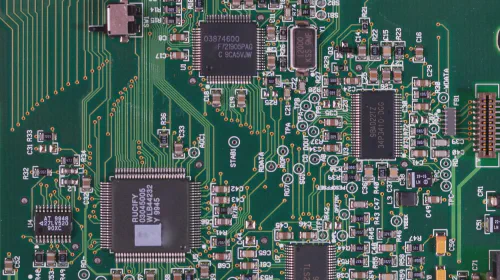Blockchain Full Nodes: Functions, Types, and More | OriginStamp
Salomon Kisters
Jun 16, 2022This post may contain affiliate links. If you use these links to buy something we may earn a commission. Thanks!
A blockchain is a decentralized database containing records stored in blocks. Each block is linked by cryptographic hashes and timestamps and can be stored in any computer that processes transactions within the blockchain.
In essence, blockchains are operated by a network of computers – called ’nodes’ – that distribute the blocks in the database. A node performs several functions that include crypto mining and storage.
While a node can store the complete set of blocks in the blockchain, there is no need for every computer to store the complete information associated with each record.
Therefore, nodes allow the database to remain distributed. They are the building blocks of the hardware that powers blockchains like Bitcoin and Ethereum.
There are two basic categories of nodes, namely full nodes and light nodes. In this article, we will focus on full nodes. But before we dive into that, let’s briefly cover some basic information about nodes.
What do nodes do?
Nodes perform three main functions.
Transaction Validation
A blockchain node checks incoming transactions if they are legitimate. The node accepts or rejects a transaction request based on the required credentials.
Storage
A node stores the record of blockchain transactions in part or whole. Direct storage helps to retrieve information faster and retain a transaction history. It is also needed to record new transactions.
Broadcasting transaction information
Information is sent to other nodes in the network that request historical data while processing transactions. Broadcasting the data in this way helps to validate other transactions and keeps other nodes synchronized with the complete blockchain record.
It’s worth noting here that several nodes allow blockchains to operate smoothly throughout the day. If one node goes offline, users can connect to other nodes to continue transacting on the blockchain.
A quick look at the number of Bitcoin nodes reveals that there are over 16,000 online nodes in 2022. That’s just a fraction of all nodes that have been connected to the blockchain.
In recent years, blockchain technology has evolved considerably to allow nodes to perform more sophisticated tasks, like issuing tokens and executing automated contracts. These functions are limited to specific networks and are usually incompatible with other blockchains.
The two main types of nodes: full nodes and light nodes
On the surface, the two node types differ on the level of information stored within them.
Full Nodes
Full nodes store the complete blockchain data. That means they contain information about all blocks and the complete record of transactions carried out within these blocks.
Full nodes, by default, contain the entire blockchain database, and that means there needs to be at least one full node in the whole network. In reality, there are several full nodes in most digital currency networks.
2021 estimates for the Bitcoin network put the number over 10,000.
As we mentioned earlier, storing the complete blockchain is not necessary for a node to operate in a block. But access to the complete record allows full nodes to perform additional tasks. We will cover these functions later in this article.
Light Nodes
Light nodes, as you can guess, only store part of the blockchain. They are ’light’ on computer resources. These nodes still index enough information to request complete evidence on specific blocks when required.
The purpose of light nodes is to work on daily transaction processing tasks that may not require access to the full database. Light nodes can improve a network’s transaction processing speed by only referring to relevant blocks in the blockchain. In other words, light nodes mainly process payments.
Types of full nodes
Now that you know the basics of blockchain nodes, we now discuss full nodes in more detail.
Full nodes can be further divided into different types.
Archival Nodes
Archival nodes simply keep the complete record of the blockchain transactions. They serve as a backup of the transaction records. Most full nodes on a blockchain are archival nodes. For older or very active blockchains, archival nodes require massive amounts of storage space.
Pruned Nodes
Pruned nodes work like archival nodes, except for having a block limit. A block limit restricts the total number of complete blocks that can be stored within the node. Previous blocks are indexed, and transactions within these blocks are removed. This helps to save space and computer memory – a process called pruning.
Pruned nodes make a blockchain network efficient by allowing efficient storage and enabling information retrieval from nodes close by. Many popular blockchains like Bitcoin Core, Ethereum, and Monero already accommodate pruned nodes, although some of them require updated protocols to implement the feature.
Because full modes can access the entire database, they have some additional functionality that makes them versatile. Full notes allow users to play different roles on the blockchain over the usual trading activity.
Mining Nodes
Full nodes can perform cryptographic calculations required to validate cryptocurrency transactions. The process can also add new blocks to a blockchain and reward the user operating that node – also called a ‘miner’ – with digital currency.
Mining nodes allow users to benefit from sharing their computers with the blockchain network, but they do require computing power to run efficiently.
Masternodes
A master node is a full copy of the blockchain that is always available online. A master node assists in synchronizing other nodes on the network. However, due to the sheer size of blockchains, master nodes require expensive hardware to keep running 24/7.
Masternodes also have administrative rights in some blockchains, meaning they can approve updates to the core network. They can update computing protocols and standards in the blockchain through a proof-of consensus algorithm in which several nodes have to agree to a change in rules.
This is like having voting power among other blockchain nodes**.** Masternodes can also charge interest on some transaction processing services.
While they sound like traditional archival nodes, master nodes differ from the latter as they charge a larger premium for these additional privileges. Their owners are required to own a large amount of digital currency in the network.
Authority Nodes
As blockchains become more active, their user count can surge and allow security vulnerabilities to appear. To keep the blockchain secure from cyber threats, some nodes need to restrict access to the blockchain.
Authority nodes function as gatekeepers to the blockchain by only allowing authorized users to enter the network. These nodes work best in blockchains that have links to centralized servers or databases.
Staking Nodes
A relatively recent addition to blockchains, staking nodes use a different type of consensus algorithm called the proof of stake.
This is a new trend that started with the Ethereum blockchain. Staking requires nodes to stake their own resources (either currency or other resources) into a transaction validation process.
The staking process can be automatically executed using different parameters like the age or uptime of the node, which seamlessly validates transactions.
The main advantage of the proof of stake protocol is that it is computationally efficient and does not tax hardware, in contrast to the proof of work protocol.
Conclusion
Blockchain nodes are an integral part of digital currency networks. With many public blockchains available, enthusiasts and professionals around the world can join a network of their choice and jump-start their crypto trading journey.
You can easily set up your full node with the right tools and knowledge.
We hope this guide gives you some useful information about full nodes. For more material on the latest development in the world of cryptocurrency and blockchain, please visit originstamp.c
Stay informed with the latest insights in Crypto, Blockchain, and Cyber-Security! Subscribe to our newsletter now to receive exclusive updates, expert analyses, and current developments directly to your inbox. Don't miss the opportunity to expand your knowledge and stay up-to-date.
Love what you're reading? Subscribe for top stories in Crypto, Blockchain, and Cyber-Security. Stay informed with exclusive updates.
Please note that the Content may have been generated with the Help of AI. The editorial content of OriginStamp AG does not constitute a recommendation for investment or purchase advice. In principle, an investment can also lead to a total loss. Therefore, please seek advice before making an investment decision.

What is Solana, and What are Its Use Cases?
Solana is a modern blockchain that differs significantly from the Bitcoin network. This post will discuss Solana and its use cases.

What is Blockchain Analytics, and How Does It Work?
You might have heard of data analytics before. But what is blockchain analytics, and how does it work?

Blockchain Light Nodes: Functions, Types, Setup, and Pros/Cons
Learn about blockchain light nodes, their functions, types, setup, and pros/cons. Understand how they work and their importance in the cryptocurrency ecosystem.
Protect your documents
Your gateway to unforgeable data. Imprint the authenticity of your information with our blockchain timestamp